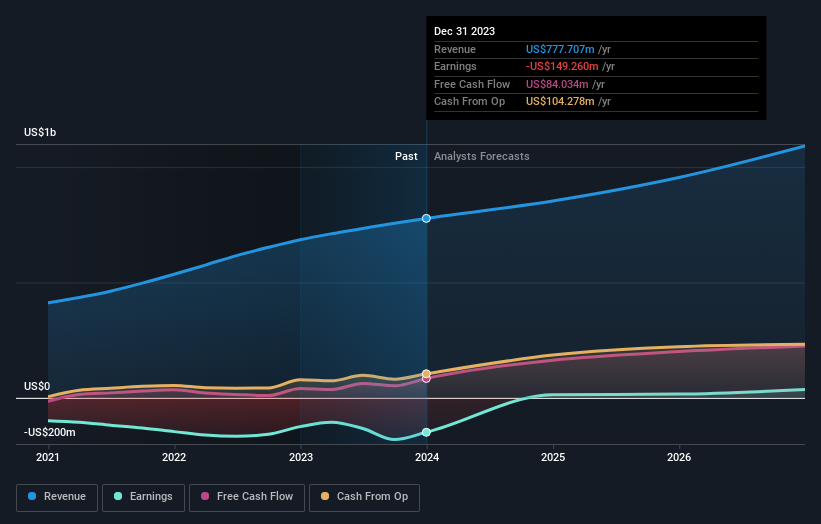Analysts Are Updating Their Rapid7, Inc. (NASDAQ:RPD) Estimates After Its Yearly Results
It's been a good week for Rapid7, Inc. (NASDAQ:RPD) shareholders, because the company has just released its latest yearly results, and the shares gained 8.2% to US$61.47. The results overall were pretty much dead in line with analyst forecasts; revenues were US$778m and statutory losses were US$2.46 per share. The analysts typically update their forecasts at each earnings report, and we can judge from their estimates whether their view of the company has changed or if there are any new concerns to be aware of. We thought readers would find it interesting to see the analysts latest (statutory) post-earnings forecasts for next year.
See our latest analysis for Rapid7
After the latest results, the 23 analysts covering Rapid7 are now predicting revenues of US$853.0m in 2024. If met, this would reflect a solid 9.7% improvement in revenue compared to the last 12 months. Rapid7 is also expected to turn profitable, with statutory earnings of US$0.16 per share. Yet prior to the latest earnings, the analysts had been forecasting revenues of US$870.0m and losses of US$0.17 per share in 2024. While there's been no material change to the revenue estimates, there's been a pretty clear upgrade to earnings estimates, with the analysts expecting a per-share profit compared to previous expectations of a loss. So it seems like the latest results have led to a significant increase in sentiment for Rapid7.
The consensus price target was unchanged at US$60.22, implying that the improved earnings outlook is not expected to have a long term impact on value creation for shareholders. The consensus price target is just an average of individual analyst targets, so - it could be handy to see how wide the range of underlying estimates is. The most optimistic Rapid7 analyst has a price target of US$70.00 per share, while the most pessimistic values it at US$45.00. This shows there is still a bit of diversity in estimates, but analysts don't appear to be totally split on the stock as though it might be a success or failure situation.
Taking a look at the bigger picture now, one of the ways we can understand these forecasts is to see how they compare to both past performance and industry growth estimates. It's pretty clear that there is an expectation that Rapid7's revenue growth will slow down substantially, with revenues to the end of 2024 expected to display 9.7% growth on an annualised basis. This is compared to a historical growth rate of 23% over the past five years. By way of comparison, the other companies in this industry with analyst coverage are forecast to grow their revenue at 13% per year. Factoring in the forecast slowdown in growth, it seems obvious that Rapid7 is also expected to grow slower than other industry participants.
The Bottom Line
The most important thing to take away is that there's been a clear step-change in belief around the business' prospects, with the analysts now expecting Rapid7 to become profitable next year. Fortunately, the analysts also reconfirmed their revenue estimates, suggesting that it's tracking in line with expectations. Although our data does suggest that Rapid7's revenue is expected to perform worse than the wider industry. The consensus price target held steady at US$60.22, with the latest estimates not enough to have an impact on their price targets.
With that said, the long-term trajectory of the company's earnings is a lot more important than next year. We have forecasts for Rapid7 going out to 2026, and you can see them free on our platform here.
You should always think about risks though. Case in point, we've spotted 3 warning signs for Rapid7 you should be aware of, and 1 of them is a bit concerning.
Have feedback on this article? Concerned about the content? Get in touch with us directly. Alternatively, email editorial-team (at) simplywallst.com.
This article by Simply Wall St is general in nature. We provide commentary based on historical data and analyst forecasts only using an unbiased methodology and our articles are not intended to be financial advice. It does not constitute a recommendation to buy or sell any stock, and does not take account of your objectives, or your financial situation. We aim to bring you long-term focused analysis driven by fundamental data. Note that our analysis may not factor in the latest price-sensitive company announcements or qualitative material. Simply Wall St has no position in any stocks mentioned.

